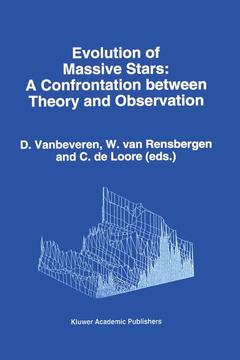Description
Evolution of Massive Stars, Softcover reprint of the original 1st ed. 1994
A Confrontation between Theory and Observation
Coordinators: Vanbeveren D., van Rensbergen W., de Loore C.
Language: English
Subject for Evolution of Massive Stars:
Keywords
Galaxy; Population; Supernova; astrophysics; galaxies; milky way; photometry; spectroscopy; star; stellar; stellar evolution; telescope
Publication date: 10-2012
490 p. · 16x24 cm · Paperback
490 p. · 16x24 cm · Paperback
Description
/li>Contents
/li>
Massive stars occupy an exceptional place in general astrophysics. They trigger many if not all of the important processes in galactic evolution whereas due to their intrinsic brightness, they offer the (only until now) possibility to study the stellar content and stellar behaviour in distant galaxies. The last, say, 25 years, massive stars have been the subject of numerous meetings discussing the influence of massive stars on population synthesis, the number distribution of different types of massive stars, the LBV phenomenon, WR stars, X-ray binaries, stellar winds in massive stars, chemical pecularities in massive stars, supernova explosions of massive stars and the important SN1987A event, the influence of massive stars and chemical evolution of galaxies. It is clear that without a theory of stellar evolution, the study of these topics loses a lot of its significance. Massive star evolution therefore got a chance in these meetings, but rarely as a prime subject. The state of the art, the physical processes and the uncertainties in stellar evolution were barely touched. Even more, the influence of close binaries in all these massive star meetings slowly disappeared the last, say, 13 years without any scientific justification, although a significant fraction of stars occurs in close binaries with periods small enough so that both components will interact during their evolution. Denying the binaries or not discussing their influence on results and conclusions, makes the latter very uncertain or even completely unreliable.
Massive stars: setting the stage.- I. Number and Distribution of Massive Stars.- The massive star distribution in the Galaxy and the Magellanic Clouds.- Massive star distribution in external galaxies and starburst region.- Dissection of 30 Doradus and a discussion of the Magellanic Cloud OB-associations.- Blue and red supergiants and the age structure of the NGC 330 region.- Stars in young clusters in the Magellanic Clouds.- The population of massive stars in R136 from HST/FOC UV observations.- Spectral synthesis of spectral populations using Balmer lines.- The stellar content of the Orion OB1 association.- II. Massive Star Atmospheres and Stellar Winds.- Observations of the atmospheres and winds of O-stars, LBV’s and Wolf-Rayet stars.- Radiation driven winds of hot stars: theory of O-star atmospheres as a spectral tool.- The chemical composition of B-supergiant atmospheres.- Intrinsic parameters of massive OB-stars.- Line blanketing by iron group elements in non-LTE model atmospheres of hot stars.- A comparison between observed and predicted mass loss rates and wind momentum of O stars.- LTE and NLTE abundances in A supergiants: a test of their evolutionary status.- A spectroscopic analysis of B-stars in the SMC cluster NGC 330.- Hydrodynamic atmosphere models for hot luminous stars II. Method and improvements over unified models.- Hubble space telescope spectroscopy of massive hot stars in the Magellanic Clouds and M31.- Stellar winds of massive stars in M31.- O-star winds in the Magellanic Clouds and the Milky Way.- On the relation between the mass loss rate and the stellar parameters of OB-type stars.- Wind asymmetries in massive stars.- NLTE analysis of hot binaries.- Effective temperatures and surface gravities of early type stars.- The atmospheric composition, extinction and luminosity of the LBV star R71.- The variability of Eta Car: a tool for the LBV phenomenon.- The nature of the luminous blue variable AG Car.- The evolutionary status of Eta Car based on historical and modern optical and infrared photometry.- The gradual acceleration of the outflow of VX Sagittari; a stellar evolution effect?.- The complex H-alpha profile of the hypergiant HR 8752 during 1970–1992.- Spectral analysis of Wolf-Rayet stars: theory, results, conclusions.- Line-blanketed non-LTE atmosphere models for Wolf-Rayet stars.- The fundamental parameters of the central stars of eight WR ring nebulae.- Tailored analysis of 24 galactic WN stars.- Oxygen and carbon abundances for the WO stars.- HD190918: arbiter between models for Wolf-Rayet stars.- III. Structure and Evolution of Massive Srars.- Structure and evolution of massive stars: mixing processes and stellar evolution.- Overshooting from convective cores: theory and numerical simulation.- Massive close binaries. observational characteristics.- Doppler tomography of O-type binaries; the physical properties of seven systems.- Evolution of massive close binaries.- Massive single star evolution: comparison with observations.- Presupernova evolution of the most massive stars.- Properties of massive star evolution.- Nucleosynthesis in massive stars.- Results of evolutionary computations of primaries of close binaries with different initial composition.- The mass and helium discrepancy in massive stars: the case Vela X-1.- On the evolution of secondary components in massive close binary systems.- Double-zone model with diffusive mixing and the mass and helium discrepancies in OB stars.- The impact of semi-convection and overshooting on the surface abundances in massive stars.- Improved bolometric corrections for WR stars.- Wolf-Rayet stars in starbursts.- A study of the SMC cluster NGC330.- The evolution of massive stars to explosion.- SN1987A and SN1993J: testing stellar evolution theory.- Chemical and photometric evolution of elliptical galaxies.- A model for the chemical evolution of the solar neighborhood using metallicity dependent yields.- Poster list.- Summary.
© 2024 LAVOISIER S.A.S.




